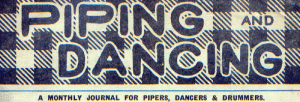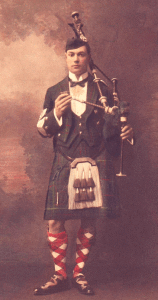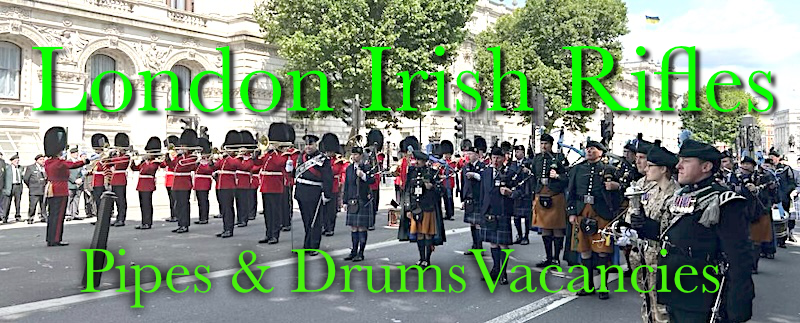We continue with our look back at piping and pipe bands of 80 years ago through the eyes and ears of the correspondents for the October 1935 Piping and Dancing Magazine…
Edinburgh Notes,
By O.A.A.
With October comes the beginning of the activities of the Piping Societies and Bands in Edinburgh. The Societies to their weekly practices and social gatherings with their variety of piping and dancing, and the Bands to their practice for next year’s engagement season or competition work, with a determination to be twice as good as in the past.
Edina [sic] can boast of five societies, and the large amount of members and the good attendance of some shows great interest taken by the people of the Capital in Piping and Dancing. Apparently it is not new to this fair city, as I have before me a photographic reproduction of an old bill, dated 1785, advertising a Pipe Competition, with 48 selections and 4 Highland dancing features. The piping was all piobaireachd.
The reader now naturally wonders about the Bands. We have nine – 5 Civilian and 4 Territorial. The one outstanding band of recent years – the Corporation Transport – are, I believe losing the services of their Pipe-Major, owing to ill-health. I would like to hear the contrary, as he is an excellent all-round man, and the Band, under his supervision, has always been in the prize-list when competing. The other bands have not competed for years, the same reason being that given last month with regard to Dancing judges. I will say this, that judging at all times is a thankless job. I remember at one games seeing a crowd of angry mothers waiting to get hold of the Dancing judge. (Enough said). The Army School of Piping, under Pipe – Major Wm. Ross, and held in the Castle, is now in full swing. To those who do not know, it is a scheme of the Piobaireachd Society to improve Army playing, particularly in the classical branch of Piobaireachd. Although I may add it is not necessary to pass through this course to become an Army pipe-major.
The Army School of Piping, under Pipe – Major Wm. Ross, and held in the Castle, is now in full swing. To those who do not know, it is a scheme of the Piobaireachd Society to improve Army playing, particularly in the classical branch of Piobaireachd. Although I may add it is not necessary to pass through this course to become an Army pipe-major.
In conclusion I wish to say how much I missed the articles on Drums, as pipers have never quite given the Drummer the credit he deserves in the Band.
From Glasgow
By ‘Grips and Gracenotes’
I witnessed a splendid display of Highland Dancing in Kelvin Hall, on Saturday night, 12th October. The dancers were Corpl. Brown, Lance-Corpl. Macrae, Piper Ackroyd, and Piper Craig, of the 2nd Batt. the Black Watch. I had a talk with their tutor, Pipe-Major C. H. Smith, and he was telling me how much they all enjoy that sort of work. They are at present stationed in Maryhill Barracks, Glasgow, where they hope to be for the next two years, and though it is hard work carrying out their normal duties through the day and entertaining a few thousand people at night, the Band, pipers and dancers, wish to thank the Glasgow Corporation for inviting them to play at their Housing and Health Exhibition. The Black Watch supplied the entertainment from the 2nd to 12th October, and the Ist Batt. the Gordon Highlanders will do service from 14th to 26th October.
Did you know that Pipe-Major Ireland of the Royal Scots, stationed in Dover, is the youngest Pipe-Major in the British Army?
Boys’ Brigade Notes
You could almost say everything was quiet in B.B. circles if you didn’t just happen to visit them while at practice. Most companies at the present time are re-building their band for another season. Some have suffered heavily through boys leaving at seventeen.
All Glasgow bands should he registered by the 7th October. If any Pipe-Major has neglected this duty, he should make all haste and relieve the Band’s convener of much worry.
Did you know that Pipe-Major C. H. Smith, of the 2nd. Batt. the Black Watch, whose pipers and dancers are assisting to entertain the multitudes at the Housing and Health Exhibition, Glasgow, is an old B.B. man? He belongs to Blairgowrie, and it was there he served as Pipe-Major to a B.B. company. It is eleven years since he left his home town, but no doubt the Blairgowrie folk still remember him, and will be pleased to know he is doing so well. He remembers all his boys and B.B. acquaintances, but he just can’t recall the number of his company. I wonder if any of our readers can help him out.
London Notes
By Iain Og
With one more Highland Games Season gathered into the past, the temporary, but inevitable reaction has set in, and amongst our competitors, back in London again, there is a strong disinclination to ‘tog oinn mo phiob’ for the time being. Pipes, that at the beginning of the season were as carefully looked after as the Culinan diamond, are now left neglected in a corner. It will be a week or two before we hear them being played at the Corporation Hall on a Friday evening.
A survey of the Games prize lists, in ‘Piping and Dancing’, the ‘Glasgow Herald’, and the ‘Oban Times’, reveals that while London competitors have accomplished nothing spectacular in Scotland, they have not done so badly. It should be remembered that there were only about half-a-dozen competitors from the Metropolis in the field, and that of these, all but two confined their efforts to Oban and Inverness.

David Ross, Rosehall, a veritable Sir Thomas Lipton of the piping world, has been unlucky once again in failing to achieve one of his most cherished ambitions – the winning of the Clasp for Piobaireachd at Inverness. He was first in the Strathspey and Reel competition at Inverness, however, and the following day took a first for Marches at Invergordon.
Pipe-Major Robertson, Scots Guards, was third in the Champions’ Class Piobaireachd at Inverness, and appears to have made a speciality of winning firsts in March competitions. There is a long list of these to his credit, won at gatherings all over the North. At Oban, Lewis Beaton, according to himself, played atrociously (this is the original remark watered down), but I have heard that he was in fine form at Inverness. He took Fourth there in the Junior Piobaireachd.
Congratulations from London to Pipe-Major Reid [pictured at the start of this article piping at Cowal in the 1930s] for winning the blue riband of Piping. We hope to see him in London again next February, at the Piping Society’s Competition, and this time to prevent his carrying off the Cup for Piobaireachd.
By the way, does anyone know the exact significance of the name of that old and little-known tune, ‘Grain in Hides and Corn in Sacks’?
[Now generally understood to mean ‘the cattle have been fed and the harvest gathered; a general feeling of satisfaction at work done and everything in order. RW]
Inverness and Piping – a London View
From all quarters we have heard that the standard of Piping at Inverness this year was exceptionally high; and this despite the fierce wind that caused so many competitors to break down on the Thursday. Mr. John MacDonald is reported to have said, in fact, that he had not heard such fine playing for years. The consensus of opinion of London pipers with experience of Inverness supports this view, but finds it paradoxical that the stage for the finest display of piping in the world should be set in a town which, while it can claim the most brilliant name in modern piping, yet has largely ceased to take a genuine interest in the bagpipes. (Please note how conducive to detachment the London piper’s position is. I have just looked up t he A. B.C., and find that the distance from Euston to the you-back-your-train-out-and-I’ll-back-my-train-in arrangement that is Inverness station is 568 miles).
Is it not true? Comparisons, they say, are odious; but never mind that, and compare Inverness with Oban. In the West Highland town the standard of playing was lower apparently, but the march of t he pipers to the field was supported by many of the Argyllshire lairds, and the whole town practically turned out in force to see them go by. In Inverness, of course, the march of the pipers has been abandoned for lack of support. The last time they marched to the field they did so alone.
By way of further criticism, I have heard from our competitors that even for the Piobaireachd competition for the Clasp at Inverness there was only a handful of listeners, most of them of the older generation. In my impressionable days the connection of Inverness with the Northern meeting led me to look upon the town as the true home of piping, and I could firmly believe that occasionally on a summer evening a piper would play a piobaireachd up by the Castle (the Invernessians standing in a hushed silence on the bridge and by the river bank below), or that pipers had a habit of playing to each other from opposite sides of the Kessock Ferry. That was before I learnt that the ‘penchant’ in the Black Isle, from Killearnan to Cromarty, was for the melodeon.
Actually, though I always see more tartan in Inverness than anywhere else, from kilts in the street to tartan dollys ad nauseam in the shop windows, I have only once heard the pipes being played in the town, and that was by a tinker outside a pub in Castle Street. It is not difficult to imagine that, unless there is a revival of interest in piping in Inverness, before long Oban (South Uist being rather far away) will hold undisputed place as the Mecca of all good pipers.
Jocular Note
At the Piper ‘s Ceilidh, at t he Imperial Hotel, Inverness, this year, we heard that there was both piping and singing. Was it really singing, or just t he usual ‘hai-hari-hum-dara-ing’ in each other’s ears?
Piping Society Notes
The Piping Society starts its winter season this year with a membership of seventy-five, which figure does not include honorary members. Friday evening meetings are not yet by any means large, but there seems to be more enthusiasm than ever before, especially among the younger members. A lot of credit for this must go to Mr. Charles Stewart, the Pipe-Major of the Society, and his ideas for collective playing. Every meeting night at about 10 o’ clock, the big table in the middle of the floor is pushed back, and Pipe-Major Stewart, much as he would like to practise ‘Mary MacLeod’, lines up his merry men instead and has them tune their pipes. This is a very popular part of the evening’s procedure, and gives confidence to the younger players. It is a pity, however, that the meeting-room is not larger. The acoustics are all right for a single player, but for group-playing they are none too good, and there is not much room to march up and down. This problem of accommodation has come before the Committee of the Society on several occasions, but it is one that has been found insoluble so far. The only other room the Society has is the small one used by the Chanter Class for an hour or so every Friday. For this, and for a player practising all by himself, it is quite suitable, but it is not an ideal place in which to listen to piping. There was a South Uist player the other Friday evening playing ‘Parker’s Welcome’ and making a lovely job of it, but in that small room the effect was spoiled.
The Committee of the Society met last Friday evening (the 11th), to decide on a date for the next Competition. This will probably be held next February, but which Saturday will be decided on receiving a list of vacant dates frorn London Scottish Headquarters.
Obituary
It is with deep regret t hat the Society has to record the loss of a Life Member and a very good friend by the death, at his English home at Ashley Green, Bucks., of Major Norman MacLeod, at the age of 76. The body was cremated at Golders Green Crematorium, and the ashes conveyed to Kilmuir, North Uist. Cha di-Chuimhnich sinn E.

















‘hai-hari-hum-dara-rawmac@gmail.com-ing’
Splendidly authentic :p